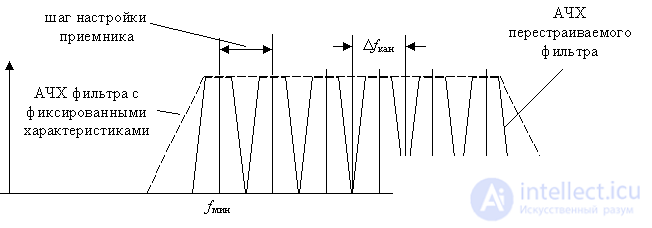Lecture
The operating frequency range is the band within which the receiver can tune.
A very important characteristic of the receiving device is the operating frequency range. Depending on the value of the received frequency, the circuit and design solutions of radio receivers can vary considerably. The concept of the operating frequency range of the receiving device is illustrated in Figure 1.

Figure 1. Receiver operating frequency range
The tuning ratio of the receiving device is determined by the ratio of the maximum received frequency to the minimum:

When constructing radio receivers with a significant ratio of the center frequency of the upper receiving channel to the center frequency of the lower receiving channel, it may be necessary to split the received frequency range into several subbands. From the same relationship may depend on whether the input circuits are tunable or you can apply filters with fixed characteristics. The difference between the requirements for the frequency response of a tunable filter and the frequency response of a filter with fixed parameters is shown in Figure 1.
It is known that filters with fixed characteristics can be performed with better frequency characteristics compared to tunable filters. In some cases, it is possible to use quartz filters or filters on surface acoustic waves (surfactants). For this reason, in developing the standards of modern mobile communication systems, in addition to the lack of frequency resource, a rather narrow range of operating frequencies was chosen (kpr = 1.1 ... 1.3).
For example, for the GSM 900 standard, the frequency range of the receiver of a mobile device is 935 ... 960 MHz. (Currently this range is extended to 921 ... 960 MHz). For base stations, the range of received frequencies is 890 ... 915 MHz. (876 ... 915 MHz) For the GSM 1800 standard, the range of received frequencies for mobile devices is 1805 ... 1880 MHz. For base stations, the range of received frequencies is 1710 ... 1785 MHz. The received frequency bands of the GSM communication system are shown in Figure 2.

Figure 2. Received frequency bands in the GSM cellular system
The situation is similar in CDMA standards. The range of received frequencies for mobile devices is 869 ... 893 MHz. For base stations, the received frequency range is 824 ... 848 MHz.
In all frequency ranges allocated for cellular communication, the maximum frequency of the received signal differs from the minimum frequency of the received signal by less than three percent. This allows in cellular communication systems to apply filters with fixed parameters in the input circuits.
With a smooth tuning range is set by the boundary frequencies  . The relative width of the range is estimated by the overlap factor.
. The relative width of the range is estimated by the overlap factor.

To ensure a large  with easy setup and preservation of quality reception parameters, the range is divided into subranges with overlap coefficients
with easy setup and preservation of quality reception parameters, the range is divided into subranges with overlap coefficients

Value  limited primarily by the design capabilities of tuning variable capacitors, which have a maximum
limited primarily by the design capabilities of tuning variable capacitors, which have a maximum  and minimal
and minimal  containers are usually in the ratio
containers are usually in the ratio
 Wherein
Wherein 
With the addition of  the parasitic capacitance of the circuit and the characteristics of the destination receiver take
the parasitic capacitance of the circuit and the characteristics of the destination receiver take  , and
, and  As a rule, the lower, the higher the operating frequencies and the required reception quality.
As a rule, the lower, the higher the operating frequencies and the required reception quality.
For dividing the range into N subranges, the method of equal coefficients is used.  or equal frequency band method for all subbands.
or equal frequency band method for all subbands.
a) Method of equal coefficients of overlapping ranges 
With this method  and
and  (*) from here
(*) from here  .Number of subranges (if calculated by (*))
.Number of subranges (if calculated by (*))

Frequency overlap of each subrange

From the obtained ratio it follows that with increasing frequency  (i.e. with increasing subband number), the width of the subband increases.
(i.e. with increasing subband number), the width of the subband increases.
b) The method of equal frequency intervals.
Here  but different
but different 

from the obtained expression, it is seen that with an increase in the number of the subrange, the overlap coefficient decreases.
The advantage of this method is the same density settings on all subranges, which allows the use of a single scale fine tuning.
The disadvantage of this method is a large number of subranges. The method is used in professional receivers.
Comments
To leave a comment
Devices for the reception and processing of radio signals, Transmission, reception and processing of signals
Terms: Devices for the reception and processing of radio signals, Transmission, reception and processing of signals